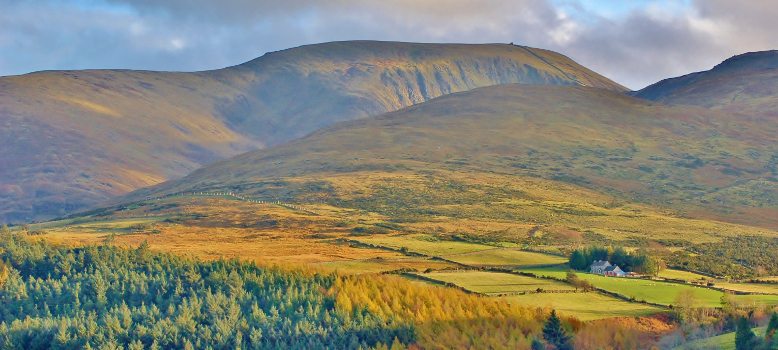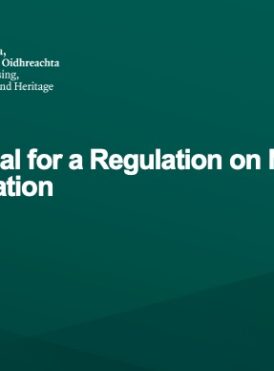Nature Restoration Law Information

IFA held an information meeting on the Nature Restoration Law held on Wednesday, 10th May in the Tullamore Court Hotel.
Five Things Farmers Do for Nature
| Fact 1: Space for Nature UCD research confirms that 12-14% of the areas on Irish farms qualifies as ‘Space for Nature’. Fact 2: Hedgerows Ireland has almost 700,000 kilometres of hedgerows covering c. 2.6% of its land area, which are protected by law. This landscape is unique to Ireland. Fact 3: Wild Bird Cover Irish farmers planted approximately 20,000 hectares of wild bird cover under the Green Low-Carbon Assurance Scheme (GLAS). To put this in context, this made wild bird cover the 4th largest crop grown in Ireland in 2020, 2.5 times larger than the area planted for potatoes. Over the period of the GLAS programme (2014-2020), according to the Central Statistics Office, the farmland bird index actually increased by almost 19%. There are some species which are under threat and many farmers are involved in projects to address this. Fact 4: The New CAP Every farmer must farm in line with the code of Good Agricultural and Environmental Practice in order to receive their EU Basic Payment. In addition, 25% of the farmers payment is ringfenced into an ‘Eco Scheme’ payment which includes allocating and maintaining ‘Space for Nature’. Furthermore, farmers can now include land which is dedicated to nature for EU payments. Under CAP regulations prior to 2023, farmers were actually penalised if this land was included for payment. Fact 5: Environment Schemes Over 46,000 farmers have applied to participate in the new Agri-Climate Rural Environmental Scheme (ACRES). This scheme has an emphasis on many measures that promote biodiversity including grassland and river margins and the planting of additional trees and hedgerows. See also ‘Irish Farmers Do a Huge Amount to Support Nature’. |
Below is an FAQ on the law and a presentation by Ainle Ni Bhriain from the National Parks & Wildlife Service.
Presentation – Proposal for a Regulation on Nature Restoration


EU Nature Restoration Regulation – Frequently Asked Questions May 2023
Background
In November last year, the Government agreed that the National Parks and Wildlife Service would have a national coordination responsibility in respect of the negotiations on the draft EU Nature Restoration Regulation and the subsequent development of the National Restoration Plan, assisted by experts from other key Government Departments.
A crucial component of implementation of the EU Biodiversity Strategy 2030, the proposed Nature Restoration Regulation provides an opportunity for transformative change in relation to achieving nature restoration in Ireland and the EU as a whole. Nature restoration will also deliver substantial co-benefits for climate action such as carbon emissions reduction from the land use sector, as well as climate adaptation and resilience through the enhancement of natural buffers against flooding and coastal inundation. Furthermore, it will deliver significant co-benefits for the water quality and ecological health of our rivers, lakes and streams.
However, planning for and achieving the legally binding targets set out, within the timescales given, will no doubt be challenging and require considerable investment, effort and resources at national, regional and local levels to implement and achieve compliance on a cross-sectoral basis.
Stakeholder engagement and involvement in the process is crucial and will be at the heart of Ireland’s planning and implementation of the Regulation at the national level.
This FAQ document has been prepared by the NPWS to provide a summary of the background and the main issues that will arise for the [agricultural] sector as we move closer to the final Regulation and the implementation phase.
What is the NPWS?
The NPWS is an executive agency within the Heritage Division of the Department of Housing, Local Government and Heritage (DHLGH), with specific responsibility for inter alia nature conservation and the implementation of various directives relating to Nature.
What is Nature Restoration?
“Restoration” means the process of actively or passively assisting the recovery of an ecosystem to a good condition. This will lead to enhanced biodiversity and ecosystem resilience. Nature restoration is a key component of efforts to halt biodiversity loss and loss of ecosystems locally, nationally and globally.
What is an ecosystem?
Ecosystem’ means a dynamic complex of plant, animal, fungiand microorganism communities and their non-living environment, interacting as a functional unit, and includes habitat types, habitats of species and species populations.
What is rewetting?
Rewetting peatland’ means the process of changing a drained peat soil towards a wet soil.
What does “Restoration measure” mean?
Restoration is a process aimed at assisting the recovery of an ecosystem that has been degraded, damaged or destroyed. The types of restoration measures needed will necessarily vary from one ecosystem to another and in function of its current state of degradation, species composition and sensitivity to change. In general, restoration can involve either passive or active measures.
Passive restoration
Passive restoration could, for instance, involve protecting an area from human pressures and allowing it to recover of its own accord. The act of removing the pressures and threats on the area is enough in itself to enable the ecosystems, and their habitats and species, to recover naturally over time.
Active restoration
Active restoration is more often needed where the ecosystems have been heavily degraded or where regular management is needed (e.g. for semi-natural habitats like hay meadows). In addition to eliminating the source of degradation, active restoration will kick start the recovery process. This could, for instance, involve restoring hydrological conditions, removing invading scrub, adapting management and land use practices, or reconnecting a river with its surrounding floodplain.
What is the Nature Restoration Regulation (NRR)?
Under the European Green Deal, the EU Biodiversity Strategy for 2030 sets out the general objective of reversing biodiversity loss, so that Europe’s biodiversity is on the path to recovery by 2030 and that by 2050 all of the EU’s ecosystems are restored, resilient and adequately protected. This is in keeping with our global commitments as well, as set out in the Kunming-Montreal Global Biodiversity Framework, adopted at COP15 of the Convention on Biological Diversity in December.
One of the commitments in the EU Biodiversity Strategy is to put forward a proposal for legally binding EU nature restoration targets. The proposed regulation on nature restoration (also known as the Nature Restoration Law) aims to fulfil this commitment.
This Regulation provides a real opportunity for transformative change in relation to achieving nature restoration in Ireland. There will be legally binding restoration targets for a broad suite of terrestrial and marine habitats and species.
It will encompass a wide range of land/sea uses including in marine, urban, agricultural and afforested environments, both in State and private ownership – with policy, legislative and sectoral implications across many Government Departments.
Key Points Raised
The NRR proposal aims to restore ecosystems, habitats and species across the EU’s land and sea areas in order to
- enable the long-term and sustained recovery of biodiverse and resilient nature
- contribute to achieving the EU’s climate mitigation and climate adaptation objectives
- meet international commitments (i.e. the United Nations Convention on Biological Diversity).
What areas are included in the Regulation?
Articles 4 to 10 of the draft Regulation will set out legally-binding targets relating to the restoration of:
- Article 4 Wetlands, forests, grasslands, river and lakes, heath & scrub, rocky habitats and dunes –
- Restoration of Terrestrial, coastal and freshwater ecosystems (listed habitats and species throughout the State)
- improve and re-establish biodiverse habitats on a large scale,
- bring back species populations by improving and enlarge their habitats
- Article 5 marine ecosystems –
- Restoration of Marine ecosystems (listed marine habitats and species throughout territorial waters)
- restore marine habitats such as seagrass beds or sediment bottoms
- restore the habitats of iconic marine species such as dolphins and porpoises, sharks and seabirds.
- Article 6 urbanecosystems –
- Restoration of Urban ecosystems (green space and tree cover)
- no net loss of green urban space by 2030, and an increase in the total area covered by green urban space by 2040 and 2050
- Article 7 river connectivity –
- Restoration the natural connectivity of rivers and functions of floodplains
- Remove artificial barriers that prevent the connectivity of surface waters, so that at least 25 000 km of rivers are restored to a free-flowing state by 2030
- Article 8 pollinating insects –
- Restoration of Pollinator populations
- reverse the decline of pollinator populations by 2030
- Article 9 agricultural ecosystems –
- Restoration of agricultural ecosystems (including drained peatlands)
- increasing grassland butterflies and farmland birds,
- Increase the stock of organic carbon in cropland mineral soils, and the share of agricultural land with high-diversity landscape features;
- restore drained peatlands under agricultural use
- Article 10 forest ecosystems –
- Restoration of Forest ecosystems
- achieve an increasing trend for standing and lying deadwood, uneven aged forests, forest connectivity, abundance of common forest birds and stock of organic carbon
What is the Nature Restoration Plan (NRP)?
Each Member State (MS) must develop a draft NRP within 24 months of the Regulation coming into force. The plan should specify how targets are to be delivered (by 2030, 2040 and 2050) for each the ecosystems in Articles 4-10.
The requirements of the NRP are set out in Articles 11 to 15 of the Regulation. The Plan, which will cover the period up to 2050, will need to:
- Quantify and map areas to be restored;
- Describe restoration measures in place and planned to reach targets;
- Outline timescales, monitoring requirements, financing needs;
Setting out a plan to 2050 is in line with the Kunming-Montreal Global Biodiversity Framework which has four long-term goals for 2050 related to the 2050 Vision for biodiversity.
What is the indicative timeframe for the Nature Restoration Regulation?
| June 2022 | Proposed regulation published by Commission |
| Current | Negotiations between Commission, Presidency and MS |
| (Ireland is represented at the Council Working Party on the Environment – WPE – which meets frequently to discuss the proposal). | |
| Late 2023 | Trilogues between European Parliament, Council and Commission |
| 2024 | Regulation comes into force |
| 2026 | NRP to be prepared |
| 2026-2030 | Implementation of NRP, including monitoring and reporting by 2030 |
| 2032 | Review of progress |
Note: Dates above are all subject to progress in EU legislative process. While it is the ambition of the Commission to have the regulation ratified and in place by the end of the year, allowing for the European Parliament to adopt a position (July) and the summer holiday break, trilogues are unlikely to start before September. and it looks like they will take some time.
What are the challenges?
- Extremely tight timeframes for quantification of targets and measures and for the preparation of national restoration plan, and for delivery of targets.
- There will need to be a considerable amount of scientific data collection, collation and analysis, including emerging information from the Land Use Review.
- The resources required for preparing, implementing and monitoring the national restoration plan are not currently in place.
At this point in time, a dedicated new EU funding instrument is not foreseen. The current EU Financial Framework is in place until 2027.
Interaction with other EU member states
Engagement with other member states has taken place, including outreach and meetings with a number of like-minded member states where we can seek to develop common positions to feed into the discussions. Ireland will continue to engage and liaise with our EU colleagues as the Regulation nears completion.
Further Information
More information can be found here.
Email: restoration@npws.gov.ie
